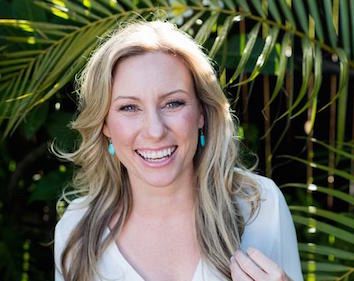Whether Damond’s death is accounted for in a legal sense will come down to the standard of "reasonableness" for acceptable use of force by police, in a country where the threshold on such reasonableness is so ground-touchingly low as to be liberatingly violent, writes Dr Binoy Kampmark.
IT PLAYS OUT as a horror story of law enforcement.
A distress call to the Minneapolis police about activity taking place behind the house on Washburn Avenue, possibly a sound of intercourse, distress, or both, taking place after 11pm during the night of July 15:
“Hi, I’m, I can hear someone out back and I, I’m not sure if she’s having sex or being raped.”
The caller, Justine Damond, had been spooked by the commotion. Damond had called her fiancé in Las Vegas, who had, in turn, insisted she call the police. When the officers arrived, an unsuspecting Damond approached the police vehicle, came up to the open driver window of Officer Matthew Harrity and was shot by his partner, Officer Mohamed Noor.
The unfurling story supplied commentators with a different combination than the usual anatomy of an American police shooting. Characters tend to be slotted along defined racial and demographic lines — the indigent black youth butchered in cold blood by a nerve wracked white officer who finds in his gun the most persuasive form of conciliation.
Not so on this occasion. The individual who is said to have pulled the trigger was a black Somali-American, whose hiring by the police department supplied politically correct, multiculti gold. Similarly, the victim was atypical for the cultural optics — a white Australian woman from Sydney, involved in the Lake Harriet Spiritual Community, all-healing, all ashram, all therapeutic.
With the reverse racial splash evident in this incident, comparisons were inevitably drawn. Now, it was time for the Somali-American community to lament.
Minneapolis City Councillor Abdi Warsame specifically noted remarks made by U.S. Republican Congresswoman Michele Bachmann that Noor may have had “cultural” reasons for gunning down Damond:
“What we are seeing is a lot of rhetoric in the media where this is a Somali issue, where this person is a Somali officer.”
Bachmann sports her own extensive laundry list of laments, specifically about Minnesota’s shifting demographics:
“Minnesota is a State that now has a reputation for terrorism.”
Politically correct brigades were attempting to muzzle those “afraid of being called "racists", "bigots", "Islamaphobes".
Fearing nothing of the sort, Bachmann described Noor as an:
“... affirmative-action hire by the hijab-wearing Mayor of Minneapolis, Betsy Hodges.”
Gross: Back in spotlight, Michele Bachmann praises Trump, addresses Minneapolis police shooting of Justine Damond https://t.co/uhryrM6gZO
— TAP (@Theresa144) July 20, 2017
In the U.S., logistical matters were picked through with the procedural attention that has become common in these casual civilian executions. The officer, it was noted, had failed to turn on his body camera. The same went for his partner. Fire arm procedures were also pondered.
Both officers had been rather green on the beat. Officer Noor, during his short stint in the force, had already encountered three civilian complaints and a law suit regarding his treatment of a woman during the course of performing a mental health check-up.
In Australia, Damond’s death engendered a feeding frenzy across the tabloid scene, a chance to capitalise on America the violent, America the vicious.
Christopher Dore of The Daily Telegraph (cited in the Star Tribune) with stomach churning enthusiasm, called her killing:
' ... the best story for us that day. You know, here’s this Aussie girl who goes over to find love. And because of the complications of American policing and guns, she’s dead.'
Others simply found such complications could never be replicated in idyllic Australia. An 'unhinged gun culture killed Justine Damond', asserted David Penberthy of Adelaide’s The Advertiser.
With soft analysis, Penberthy said:
'Justine Damond is the first Australian victim of a gun culture that betrays the promise of America.'
David Penberthy: An unhinged gun culture killed Justine Damond - The Advertiser https://t.co/HomZBeepV8
— Culture World (@CultureWrld) July 22, 2017
The response from a police force caught off guard has also been rattling in its insensibilities. When a shooting incident takes place, blame the deceased whose guilt is taken to the grave. Noor, through his legal representatives, has suggested just that. He claims essentially two things: first, that Damond was in a drug-induced state when she approached the vehicle and second, that being in such a state somehow warranted his actions.
Claimed Noor's legal representative on Thursday:
“It would be nice to know if there was any (prescription sedative) Ambien in her system.”
It would also be nice to know what darkened state of mind the officers in question were in answering the distress call put out by Damond. The suggestion that Damond might have been on medication, let alone any bodily impurity, sparked something of a tussle: the world of clean living against that of the mind altering nightmare. A pure Australian, battling a contaminated culture.
A family spokesman, Tom Hyder, said:
“Justine was someone who only ate organic, she watched everything she ever put into her body. She is not someone who would have used drugs.”
Heads have rolled. Police Chief Janeé Harteau is, thus far, the most prominent scalp. Her own period had been marked by allegations of inappropriate handling regarding previous police shootings, notably that of Jamar Clark.
Mayor Hodges insisted that Harteau hang up her hat as chief, which she did:
“I’ve lost confidence in the Chief’s ability to lead us further … It is clear that she has lost the confidence of the people of Minneapolis as well.”
So, it would seem, have residents in Minneapolis with the whole law enforcement apparatus, having found reform in the police force lethargic at best, superficial at worse. Whether Damond’s death is accounted for in a legal sense will come down to the acceptable use of force by police — one governed by that ever precarious standard of “reasonableness”. (Can a shooter ever be reasonable?)
In the U.S., the threshold on such reasonableness is so ground-touchingly low as to be liberatingly violent.
Jim Bueermann, former police chief of Redlands in California, complained:
“People just say, if a person was unarmed, why would an officer have shot him or her?”
Best, then, never to call, approach or consult an officer on duty.
Dr Binoy Kampmark was a Commonwealth Scholar at Selwyn College, Cambridge. He lectures at RMIT University, Melbourne. You can follow Dr Kampmark on Twitter @bkampmark.

This work is licensed under a Creative Commons Attribution-NonCommercial-NoDerivs 3.0 Australia License
The death of Justine Damond and Australia's fear-based police state https://t.co/lgmoPWJFgv @IndependentAus
— Michelle Pini (@vmp9) July 18, 2017
Monthly Donation
Single Donation
Read between the lines. Subscribe to IA.











